Article reprinted with permission of The Neighborhood Buzz.
A Park is Twice Reborn
The Quarry Park in Hastings-on-Hudson
By Ken Valenti
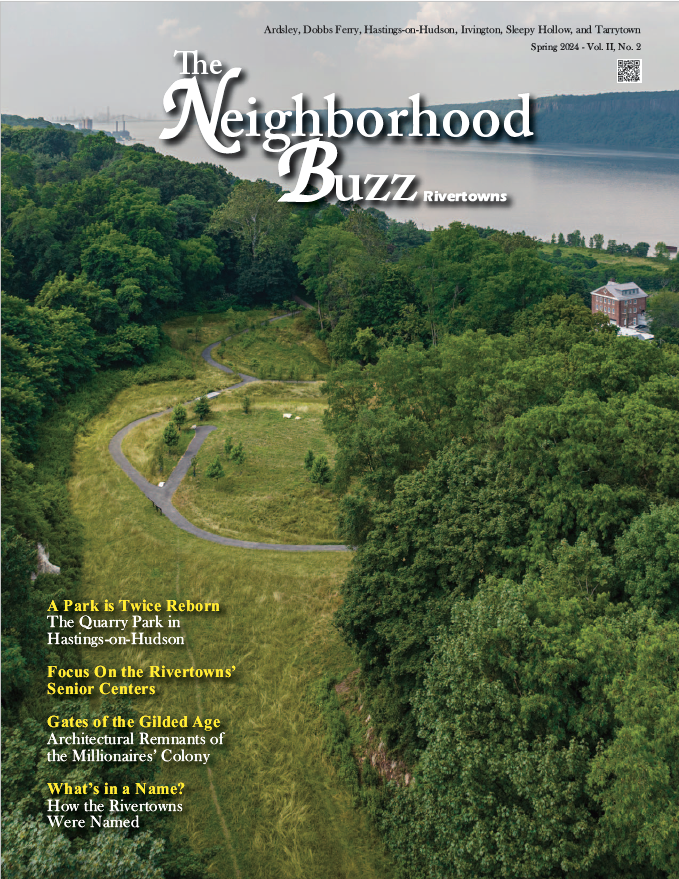
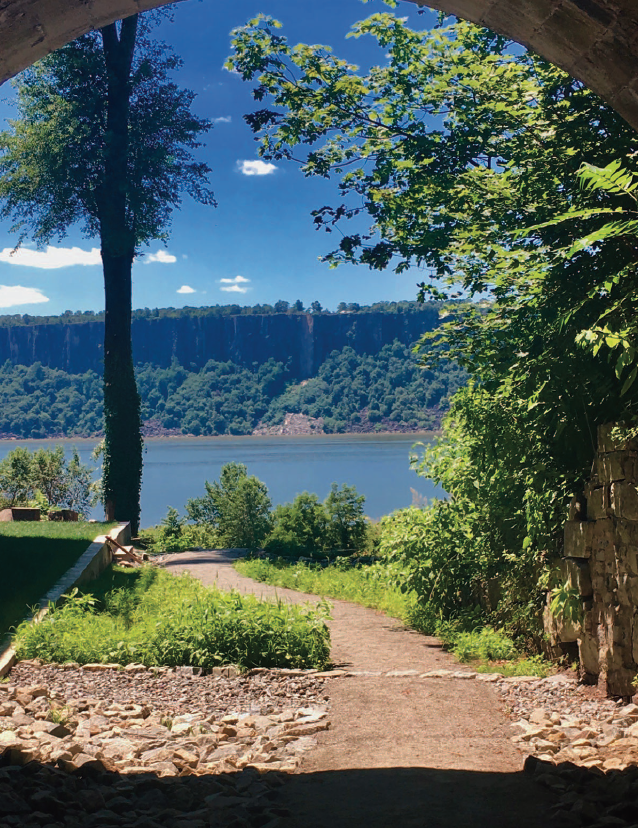
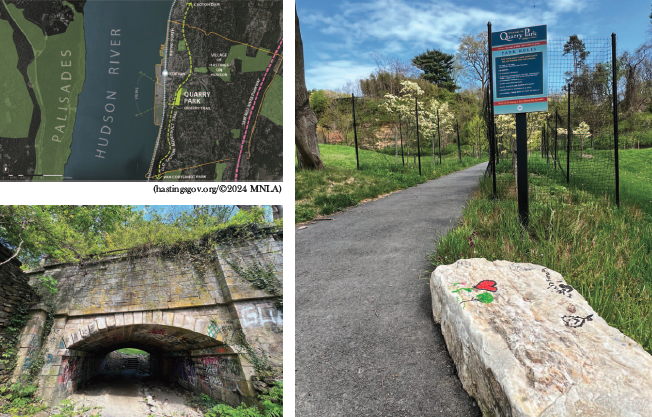
The allure of Quarry Park in Hastings-on-Hudson lies in its pastoral grounds for strolling and resting as well as its story. The 5.5-acre parcel took two decades to transform from a dump, where tires sometimes caught fire, to a refuge along the Old Croton Aqueduct Trail.
This rebirth, however, is only the latest chapter in the history of a site that hosted Hastings’ oldest industry, twice became an eyesore, and now is twice reborn. In vastly different eras, it provided marble for the home of movieland’s “Glinda, the Good Witch of the North” and became the site where top-secret papers related to U.S. nuclear strategy were hidden and then lost.
Many people are already enjoying the park even though the official opening is Sunday, June 23, 2024, with an event named “Marbleous! Hastings-on-Hudson Celebrates Quarry Park.” A ribbon cutting will begin the day and historic photographs and displays, quarry-related kids’ games and art activities, live music, picnicking, and more will be offered. This will mark a happy ending to a chapter that began when resident Christina Lomolino urged the village’s Board of Trustees to end dumping at the site and to do something with the area that people could love. “It’s been quite an adventure, with so many people playing a role and so many organizations that teamed up with our committee over time,” said Lomolino, founder of the Quarry Park project and chair of the Quarry Park Committee. It became a park thanks in part to alliances with Scenic Hudson, Riverkeeper, the Hastings Historical Society, and Friends of the Old Croton Aqueduct, as well as others.
The history of the plot of land is detailed on a series of plaques at the park and on the village’s website, based on research by the Hastings Historical Society. Its story began in 1828, with the quarrying of white dolomite marble that was prized for the purity of its whiteness and its scarce veins. It was used largely to build landmark institutions and the homes of the rich, according to Hastings Historical Society President Natalie Barry. This included Burkeley Crest, the home of Billie Burke, an actress and Hastings resident who many today would recognize as Glinda in the 1939 film The Wizard of Oz. The marble also was transported to the river via an inclined railroad and was shipped off to be used in buildings such as Marble Collegiate Church in Manhattan and the U.S. Custom House in Charleston, South Carolina. “It established Hastings as a sort of industrial base before the train came through,” Barry stated.
A court decision closed the quarry in 1871 after a blast damaged a wall on the property of a neighbor, the scientist John William Draper, who already was suing the company to cease operations. For the following 65 years, the site was put to various uses. At one point, the former quarry ended up in the hands of the Anaconda Wire and Cable Company, which prized a 35-foot-deep lake on the property with fresh water that the company piped down to its operations by the Hudson River. Over the decades, the site filled with discards. One newspaper account referred to it as “the eyesore of the town” and “a filth-infested hole in the ground.”
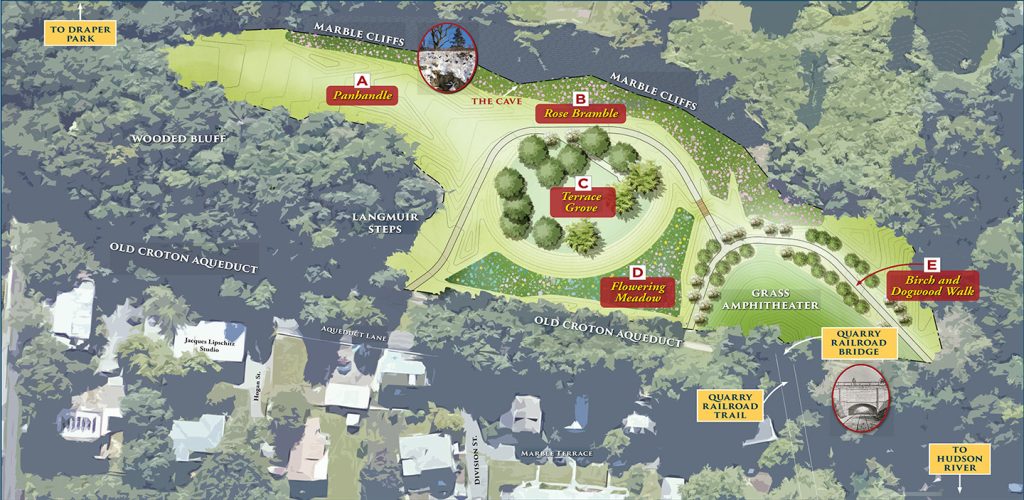

In 1936, Arthur C. Langmuir, a retired chemical engineer, master photographer, and horticulturalist, bought the property from Anaconda and transformed it into a park inspired by Buttes Chaumont in Paris, another public park that was born from an abandoned quarry. Under Langmuir’s direction, more than 50 truckloads of debris, including old auto bodies, were removed. Over three years, a crew of 12 men, “The Quarry Gang,” transformed the quarry into a park and bird sanctuary, with 2,000 newly planted trees, 1,000 rose bushes, and 800 shrubs. They built gravel paths, sweeping stone stairways, and benches overlooking the Palisades and Hudson River. According to Barry, Langmuir dubbed the water body “Lake Superior,” and he added a rowboat called the Queen Mary. He offered the park to the village as a gift, but the village declined, likely due to budget constraints.
In 1964, more than 20 years after Langmuir and his wife had died, the village bought the site as a place to dispose of household waste. The land began to fill up with rusted bedsprings as well as used mattresses, car tires, and stoves. The lake disappeared entirely. By 1967, neighbors were complaining of odors, smoke, fire, and unsightly piles of trash.
In 1971, the quarry played a tangential role in a national scandal. Daniel Ellsberg, famous for leaking the Pentagon Papers that contained the U.S. government’s secret strategy to expand the war in Vietnam, gave other secret papers he’d purloined to his brother Harry, who lived in Hastings. These concerned secret nuclear strategies. When Harry heard that the FBI was snooping around, he buried the papers on the old quarry site. The following year, a tropical storm ravaged the site, and the papers were lost. “It’s possible that those papers are in the foundation of a condo building,” Barry noted.
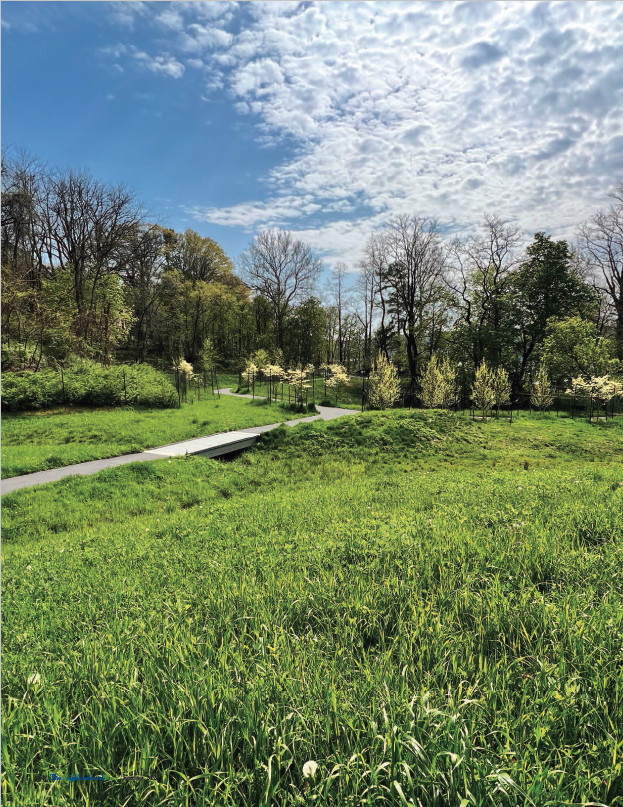
Meanwhile, refuse continued to collect there. Lomolino began attending Board of Trustees meetings to advocate for improvement of the site. In 2002, the trustees ended the site’s use as a dump. The village also set up the committee to determine the site’s future. It took two decades to secure funding through grants, plan the park, and coordinate with agencies such as the New York State Department of Environmental Conservation. Lomolino credits the support and efforts of Hastings Mayor Nicola Armacost and former Mayor Peter Swiderski in moving the project forward.
Prominent architects vied for the rare opportunity to design a park in a former quarry. Matthew Nielsen Landscape Architects of Manhattan were chosen and modeled the park after its earlier version. According to their website, the design includes “undulating mounds covered with meadow grass and woven with pathways,” two areas conducive to gatherings and community events, and an elevated plane with shade trees that “allow for picnics or small gatherings.
Additional spaces frame walking trails as well as a small concert venue where adjacent cliff faces provide ideal acoustical conditions.”
The park, a Pollinator Pathway site, is planted with native meadow grasses, wildflowers, and trees, contributing to the local ecology and supporting nesting birds, bees, butterflies, and small animals. Fifty-one trees—red maple, dogwood, birch, and beech—were planted. One thousand rose bushes were installed to pay tribute to Langmuir’s park. The new park has a birch and dogwood walk, a wildflower meadow, tall marble cliffs, an intriguing stone cave, a small forest called the “Wooded Bluff” and a feature known as the Langmuir steps. The path of the old inclined railroad is now a trail. “As you proceed toward the river from the park, you pass under two beautiful nineteenth-century bridges and then this incredible view of the Hudson River opens up,” Lomolino said.
“I hope that future generations enjoy the park and keep it wild. People are in the park every day. It is extremely well used and contributes to walkability in the village. You can just walk down the aqueduct trail and swing into the park for a few peaceful minutes in nature and then continue back on the aqueduct. It’s an important asset for our community,” according to Lomolino.
